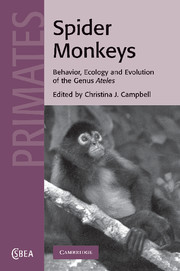Book contents
- Frontmatter
- Contents
- List of contributors
- Acknowledgements
- 1 Introduction
- Part I Taxonomy, phylogeny and evolution
- Part II Ecology
- Part III Behavior and reproduction
- Part IV Interactions with humans
- 13 Spider monkey conservation in the twenty-first century: recognizing risks and opportunities
- 14 The ethnoprimatology of spider monkeys (Ateles spp.): from past to present
- Index
- References
14 - The ethnoprimatology of spider monkeys (Ateles spp.): from past to present
Published online by Cambridge University Press: 05 May 2010
- Frontmatter
- Contents
- List of contributors
- Acknowledgements
- 1 Introduction
- Part I Taxonomy, phylogeny and evolution
- Part II Ecology
- Part III Behavior and reproduction
- Part IV Interactions with humans
- 13 Spider monkey conservation in the twenty-first century: recognizing risks and opportunities
- 14 The ethnoprimatology of spider monkeys (Ateles spp.): from past to present
- Index
- References
Summary
Introduction
Human and nonhuman primates share a relatively recent history of interaction in the New World in comparison with the Old World. The earliest known platyrrhine fossils only date back to the late Oligocene in Bolivia (e.g. Rosenberger et al., 1991; Takai et al., 2000). The earliest definitive evidence of human beings in South America does not occur until approximately 30 million years later around 12 500 years ago in Chile (Dillehay, 1989, 1997). Current evidence cannot reliably place humans in Amazonia earlier than 11 000 years ago (Roosevelt et al., 1991, 1996). Nevertheless, the roughly 10 000 years of human–nonhuman primate sympatry provides a long history of interaction among numerous Neotropical primate species and diverse human cultures.
The term “ethnoprimatology,” coined by Sponsel (1997), is a newly emerging subdiscipline of anthropology that bridges primatology and cultural anthropology. Primatologists tend to focus their research on understanding the behavior and ecology of a particular primate species or subspecies. Perhaps the most studied aspect of human–nonhuman interactions by primatologists has involved human development and deforestation of primate habitats over the last 500 years. With so many of the world's primate species endangered or threatened, such an approach is logical, meaningful, and most certainly critical for understanding the consequences of human behavior to the quite literal survival of many nonhuman primate species. It is likely that human influence of primate habitats extends even further back in time (e.g. pre-Columbian Mesoamerica; see Kirch, 2005).
- Type
- Chapter
- Information
- Spider MonkeysThe Biology, Behavior and Ecology of the Genus Ateles, pp. 377 - 403Publisher: Cambridge University PressPrint publication year: 2008
References
- 12
- Cited by



